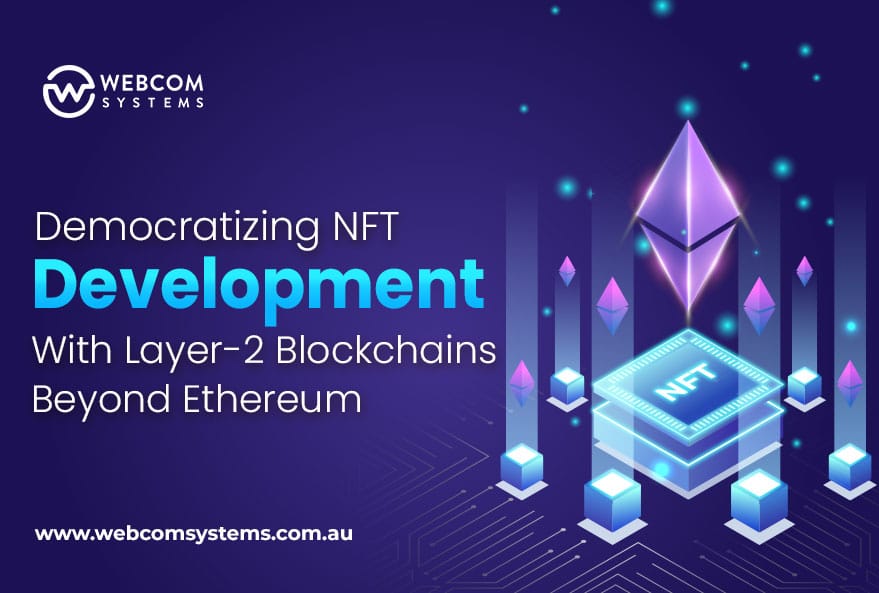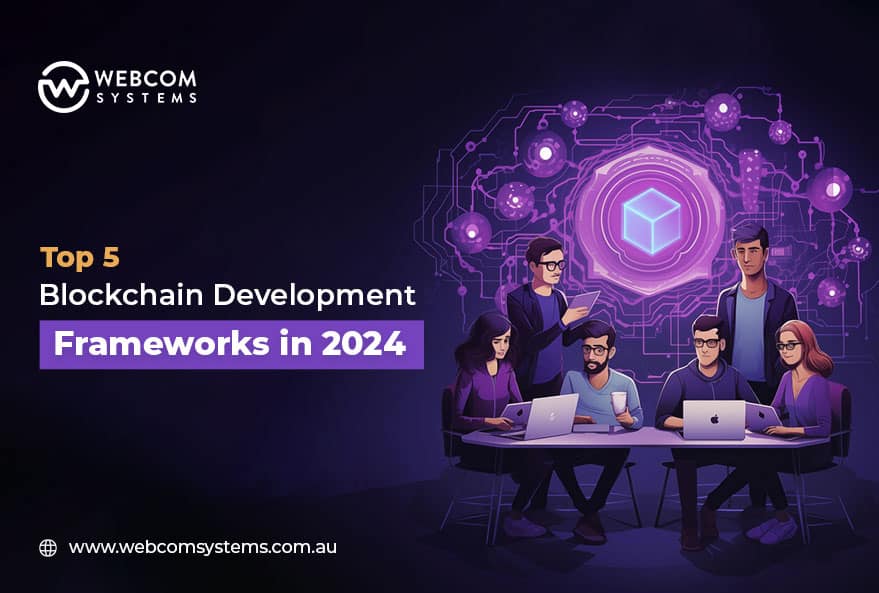Democratizing NFT Development with Layer-2 Blockchains Beyond Ethereum
Category : Blockchain / by Andrew
Ethereum currently stands as the leading force in blockchain technology, with a high volume of transactions and sales. The platform is actively developing innovative solutions to address issues regarding scalability, energy efficiency, and transaction costs. Layer 2 solutions emerge as a solution to these challenges, enhancing transaction speeds and providing suitable prices. This solidifies Ethereum’s position as the leading blockchain and changes the NFT Development landscape with innovative solutions.
This article explores the creation of NFTs on Layer-2 blockchains and its benefits. It further provides a list of popular Layer-2 blockchains you can consider for NFT development.
Layer-2 Solutions In The Development of NFTs
The Layer-2 solutions, such as ImmutableX, address the complexities of Ethereum’s NFT trading ecosystem. Utilizing Layer-2s for mining and trading NFTs will improve cost effectiveness and the strong security associated with the Ethereum mainnet. This is especially important for decentralized games that integrate NFT as an in-game asset, as Layer-2 solutions promise faster connections that are essential for seamless gaming experiences.
Challenges of NFTs: The Role of Layer-2 Solutions In Overcoming Them
The NFT ecosystem faces various challenges as the demand for NFT continues to grow. Layer 2 solutions play a crucial role in addressing these challenges.
- Scalability Issues: Ethereum experiences delays and high fees due to the strain caused by NFT transactions. Layer-2 networks utilize side chains, facilitating off-chain transactions that result in faster processing, reduced congestion, and lower fees.
- High Gas Fees: High fees on the main blockchain create obstacles for small-scale participants in the NFT space. Layer-2 technology effectively reduces gas fees, enhancing accessibility for individuals looking to engage in the NFT market.
- Interoperability Issues: The transfer of NFTs encounters challenges when crossing blockchains. Layer-2 solutions introduce bridges that provide seamless NFT transfers between networks.
- Environmental Impact: The environmental impact of Ethereum’s energy consumption raises environmental concerns. Layer-2 networks within NFT ecosystems integrate green consensus protocols, promoting eco-friendly practices and contributing to enhanced global environmental sustainability.
- Limited Smart Contract Functions: Certain blockchains impose limitations on the capabilities of NFT smart contracts. Layer-2 solutions simplify smart contracts, provide developers with advanced features, and enhance their creativity.
- Privacy Issues: Certain networks compromise user privacy during NFT transactions. The Layer-2 solution integrates privacy-focused technologies, enhancing the security of user data while ensuring transparency in NFT communications.
- Storage Issues: Storing large NFT files directly in blockchains incurs high costs. The Layer-2 solution uses a decentralized storage network, reducing costs and ensuring the continuous availability of NFTs.
- Marketplace Fragmentation: The fragmentation of NFT marketplaces poses challenges to user efficiency. Layer-2 solutions set up decentralized marketplaces across the blockchain, streamlining NFT trading on a unified platform.
- Onboarding Barriers: A complicated onboarding process creates barriers for new users to enter the NFT space. Layer-2 blockchain simplifies user onboarding and provides a user-friendly experience for NFT operations and trading.
Benefits of Developing NFTs in Layer-2 Blockchains
Developing NFTs on Layer-2 blockchains offers a wide range of advantages. These include,
- Rapid Transactions: They enable fast transactions, boasting speeds exceeding 9,000 TPS. This ensures quick and responsive interactions within the world of NFTs.
- Peer-to-Peer Trades At No Cost: It enables fee-less services, allowing for seamless and cost-effective peer-to-peer trading interactions.
- Customized Trading Costs: Companies can set and manage their trading fees, offering flexibility and customization options for NFT projects.
- Enhanced Scalability: Companies can adopt superior scalability through Layer-2 solutions, facilitating the seamless expansion and growth of NFT ecosystems with improved efficiency.
- Non-Centralized Sidechain: They empower individuals to delve into the decentralized aspects of Layer-2 technology, offering a non-centralized sidechain for NFT development while upholding the principles of decentralization.
- Private Key Protection: Users can enjoy a high level of security with strong protection for their private keys. It ensures maximum protection for their NFT assets.
- L1 Feature Inheritance: Businesses can incorporate and embrace the powerful features of Layer-1 networks, laying a solid foundation for building and maintaining NFTs on a Layer-2 platform.
- Eco-Friendly Operation: It establishes a completely carbon-free work environment, enabling sustainable and environmentally friendly NFT development and practices.
Popular Layer-2 Blockchains for NFT Development
Various Layer-2 Blockchains Significantly Influence NFT Development, Each Offering Distinct Features.
-
ImmutableX
ImmutableX stands out as an influential player in the NFT landscape, offering a scalable, affordable, and environmentally friendly approach to NFT creation and trading. It adopts ZK rollup technology, facilitates fast and high-volume transactions, and makes it ideal for NFT projects that require immediate stability. By determining its market and eliminating gas costs, ImmutableX empowers developers to thrive in the gas-free NFT ecosystem.
-
zkSync Era
The zkSync Era stands as a top-tier option for NFT developers, incorporating effective ZK-rollup technology on the Ethereum blockchain. It enhances transaction speeds and lowers costs, catering to essential requirements for NFT collections. Its integration with the Ethereum mainnet ensures security and positions it as the best option for NFT markets like Kreatorland and Element Market.
-
Polygon
Polygon is a leading Layer-2 scaling solution for Ethereum, providing cost-effective and fast transactions essential for NFT trading. It aims to balance the strengths of Ethereum with increased scalability and has achieved massive adoption with over 250 DApps, 20 million transactions, and 390,000 unique wallet users. Notable NFT projects like Planet IX, Aavegotchi, The Sandbox, and Collect Trump Cards rely on Polygon’s solutions.
-
Arbitrum
Arbitrum is a Layer-2 scaling solution for Ethereum that uses rollup technology to increase performance and support easy smart contract migration. It has attracted many developers due to its unique delayed finality system with fraud proofs. Arbitrum is one of the largest Ethereum scaling solutions, with more than 130,000 daily users, 40,000 transactions per second, and a total locked value (TVL) of $2.22 billion.
-
Base
Base is a recently launched Layer-2 solution by Coinbase, built on Optimism’s OP Stack. The base supports various functionalities within the blockchain space, including NFTs, DeFi, gaming, and social finance. It has established itself as one of the most secure and scalable Ethereum Virtual Machine (EVM) Layer-2 solutions.
-
Ronin
Ronin was originally developed in 2021 as a sidechain for Axie Infinity to address the issue of high transaction fees and slow processing times on the Ethereum mainnet. In 2023, Ronin introduced its Utility Token (RON) and transformed it into a Delegated Proof-of-Stake (DPoS) network to improve decentralization, speed, and efficiency. Ronin is an EVM-compatible sidechain that offers low transaction fees, increased affordability, and a seamless user experience.
Bottomline
Layer-2 blockchains have the potential to democratize NFT development by addressing Ethereum’s limitations, such as high gas costs and scalability issues. The evolving NFT landscape presents challenges that require solutions for growth in the digital asset ecosystem. The Layer-2 network provides a flexible and interoperable system for better accessibility. The above list of Layer-2 blockchains designed for NFT development addresses the various challenges of NFT development. These solutions address the issues related to scalability, transaction speed, gas charges, and environmental impact.
Webcom Systems excels in providing advanced Layer 2 solutions designed specifically for NFT development. Utilizing the latest technology, our platform ensures faster transaction speeds, reduced accidents, and lower gas costs, thereby improving the overall quality of the NFT experience. By implementing a Layer 2 scaling solution, we increase the performance and scalability of NFT ecosystems, making them more accessible and user-friendly. By collaborating with our experts, you can use our unique functionality to run NFTs on the Layer 2 blockchain. Partner with us today for a seamless integration of innovative Layer 2 solutions and experience success in the digital asset space
Also Read: Boost Your Crypto Venture with Stablecoin Development in 2024




